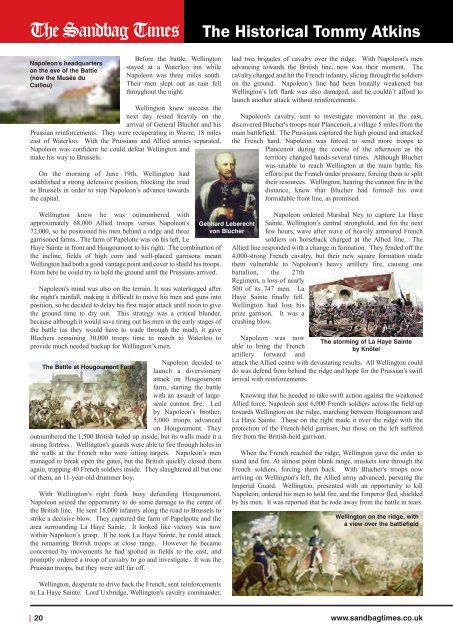The Sandbag Times Issue No: 22
The Veterans Magazine
The Veterans Magazine
- No tags were found...
Create successful ePaper yourself
Turn your PDF publications into a flip-book with our unique Google optimized e-Paper software.
<strong>The</strong> Historical Tommy Atkins<br />
Napoleon's headquarters<br />
on the eve of the Battle<br />
(now the Musée du<br />
Caillou)<br />
Before the battle, Wellington<br />
stayed at a Waterloo inn while<br />
Napoleon was three miles south.<br />
<strong>The</strong>ir men slept out as rain fell<br />
throughout the night.<br />
Wellington knew success the<br />
next day rested heavily on the<br />
arrival of General Blucher and his<br />
Prussian reinforcements. <strong>The</strong>y were recuperating in Wavre, 18 miles<br />
east of Waterloo. With the Prussians and Allied armies separated,<br />
Napoleon was confident he could defeat Wellington and<br />
make his way to Brussels.<br />
On the morning of June 19th, Wellington had<br />
established a strong defensive position, blocking the road<br />
to Brussels in order to stop Napoleon’s advance towards<br />
the capital.<br />
had two brigades of cavalry over the ridge. With Napoleon's men<br />
advancing towards the British line, now was their moment. <strong>The</strong><br />
cavalry charged and hit the French infantry, slicing through the soldiers<br />
on the ground. Napoleon’s line had been brutally weakened but<br />
Wellington’s left flank was also damaged, and he couldn’t afford to<br />
launch another attack without reinforcements.<br />
Napoleon's cavalry, sent to investigate movement in the east,<br />
discovered Blucher's troops near Plancenoit, a village 5 miles from the<br />
main battlefield. <strong>The</strong> Prussians captured the high ground and attacked<br />
the French hard. Napoleon was forced to send more troops to<br />
Plancenoit during the course of the afternoon as the<br />
territory changed hands several times. Although Blucher<br />
was unable to reach Wellington at the main battle, his<br />
efforts put the French under pressure, forcing them to split<br />
their resources. Wellington, hearing the cannon fire in the<br />
distance, knew that Blucher had formed his own<br />
formidable front line, as promised.<br />
Wellington knew he was outnumbered with<br />
approximately 68,000 Allied troops versus Napoleon's<br />
72,000, so he positioned his men behind a ridge and three<br />
garrisoned farms. <strong>The</strong> farm of Papelotte was on his left, Le<br />
Haye Sainte in front and Hougoumont to his right. <strong>The</strong> combination of<br />
the incline, fields of high corn and well-placed garrisons meant<br />
Wellington had both a good vantage point and cover to shield his troops.<br />
From here he could try to hold the ground until the Prussians arrived.<br />
Napoleon's mind was also on the terrain. It was waterlogged after<br />
the night's rainfall, making it difficult to move his men and guns into<br />
position, so he decided to delay his first major attack until noon to give<br />
the ground time to dry out. This strategy was a critical blunder,<br />
because although it would save tiring out his men in the early stages of<br />
the battle (as they would have to wade through the mud), it gave<br />
Bluchers remaining 30,000 troops time to march to Waterloo to<br />
provide much needed backup for Wellington’s men.<br />
Napoleon decided to<br />
<strong>The</strong> Battle at Hougoumont Farm<br />
launch a diversionary<br />
attack on Hougoumont<br />
farm, starting the battle<br />
with an assault of largescale<br />
cannon fire. Led<br />
by Napoleon's brother,<br />
5,000 troops advanced<br />
on Hougoumont. <strong>The</strong>y<br />
outnumbered the 1,500 British holed up inside, but its walls made it a<br />
strong fortress . Wellington's guards were able to fire through holes in<br />
the walls at the French who were sitting targets. Napoleon’s men<br />
managed to break open the gates, but the British quickly closed them<br />
again, trapping 40 French soldiers inside. <strong>The</strong>y slaughtered all but one<br />
of them, an 11-year-old drummer boy.<br />
With Wellington's right flank busy defending Hougoumont,<br />
Napoleon seized the opportunity to do some damage to the centre of<br />
the British line. He sent 18,000 infantry along the road to Brussels to<br />
strike a decisive blow. <strong>The</strong>y captured the farm of Papelpotte and the<br />
area surrounding La Haye Sainte. It looked like victory was now<br />
within Napoleon’s grasp. If he took La Haye Sainte, he could attack<br />
the remaining British troops at close range. However he became<br />
concerned by movements he had spotted in fields to the east, and<br />
promptly ordered a troop of cavalry to go and investigate. It was the<br />
Prussian troops, but they were still far off.<br />
Wellington, desperate to drive back the French, sent reinforcements<br />
to La Haye Sainte. Lord Uxbridge, Wellington's cavalry commander,<br />
Gebhard Leberecht<br />
von Blücher<br />
Napoleon ordered Marshal Ney to capture La Haye<br />
Sainte, Wellington’s central stronghold, and for the next<br />
few hours, wave after wave of heavily armoured French<br />
soldiers on horseback charged at the Allied line. <strong>The</strong><br />
Allied line responded with a change in formation. <strong>The</strong>y fended off the<br />
4,000-strong French cavalry, but their new square formation made<br />
them vulnerable to Napoleon's heavy artillery fire, causing one<br />
battalion, the 27th<br />
Regiment, a loss of nearly<br />
500 of its 747 men. La<br />
Haye Sainte finally fell.<br />
Wellington had lost his<br />
prize garrison.<br />
crushing blow.<br />
It was a<br />
Napoleon was now<br />
able to bring the French<br />
artillery forward and<br />
<strong>The</strong> storming of La Haye Sainte<br />
by Knötel<br />
attack the Allied centre with devastating results. All Wellington could<br />
do was defend from behind the ridge and hope for the Prussian's swift<br />
arrival with reinforcements.<br />
Knowing that he needed to take swift action against the weakened<br />
Allied force, Napoleon sent 6,000 French soldiers across the field up<br />
towards Wellington on the ridge, marching between Hougoumont and<br />
La Haye Sainte. Those on the right made it over the ridge with the<br />
protection of the French-held garrison, but those on the left suffered<br />
fire from the British-held garrison.<br />
When the French reached the ridge, Wellington gave the order to<br />
stand and fire. At almost point blank range, muskets tore through the<br />
French soldiers, forcing them back. With Blucher's troops now<br />
arriving on Wellington's left, the Allied army advanced, pursuing the<br />
Imperial Guard. Wellington, presented with an opportunity to kill<br />
Napoleon, ordered his men to hold fire, and the Emperor fled, shielded<br />
by his men. It was reported that he rode away from the battle in tears.<br />
Wellington on the ridge, with<br />
a view over the battlefield<br />
| 20 www.sandbagtimes.co.uk


















